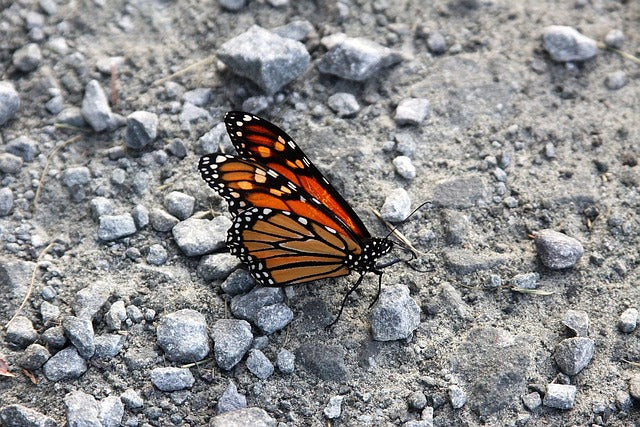
New Year’s Count of Western Monarchs Reveals High Seasonal Decrease Following Severe Winter Storms
Share
Original Article: New Year’s Count Of Western Monarchs Reveals High Seasonal Decrease Following Severe Winter Storms – Western Monarch Count

By Isis Howard
March 2023
The Xerces Society’s Western Monarch Count results for the New Year’s period are now in, revealing a 58% seasonal decrease in the overwintering western monarch population. Although the overall number of western monarchs counted for the New Year’s count remains relatively high compared to recent years — with more than 116,000 butterflies reported — the 58% seasonal decrease exceeds the typical range of 35–49% observed over the previous six winters.
The decrease is based on monitoring at 169 overwintering sites visited during both the Thanksgiving and New Year’s count periods by community science volunteers and partners. The New Year’s count serves as a follow-up to the annual Thanksgiving count to help scientists track how the western monarch population changes throughout the overwintering season as well as providing an estimate of how many butterflies remain to begin the spring breeding population.
The seasonal decrease is likely due to a combination of factors: mortality from winter storms, predation and other causes, as well as butterflies leaving the overwintering sites. As climate change and other factors like habitat loss and pesticides continue to imperil the monarch butterfly, conservation efforts and legal protections are becoming increasingly important.
“Small populations are particularly vulnerable to being snuffed out by extreme weather, so we are lucky these storms occurred in a relatively good year,” said Pelton. “We don’t want to count on luck alone to ensure the survival of the western monarch migration.”
Volunteers turn out impressive survey effort despite the downpour
Even with severe back-to-back storms, Western Monarch Count participants surveyed a total of 177 western monarch overwintering sites and estimated 116,758 butterflies for the New Year’s count, which ran from December 24, 2022, through January 8, 2023. New Year’s count data is available on the Western Monarch Count website.
Of the 169 sites monitored during both the Thanksgiving and the New Year’s counts, monarch estimates declined at 119 sites, increased at 14 sites, remained unchanged at one site, and 34 sites hosted zero monarchs during both counts. The majority of overwintering butterflies were observed along the Central Coast, with approximately 49% of butterflies reported in San Luis Obispo County, 28% in Santa Barbara County, 11% in Monterey County and 10% in Santa Cruz County.
While some sites host monarchs all winter long, others are only used for a few months or weeks. These sites are still overwintering sites, but are considered to be more temporary or transitional sites, suggesting they provide less-than-ideal habitat quality. Monitoring several times throughout the overwintering season helps scientists better understand how monarch butterflies are using overwintering sites and which sites would benefit most from active management and protection.
Figure 2. Total monarchs reported and number of overwintering sites monitored for the Western Monarch New Year’s Count from Dec. 2016 to Jan. 2023.
Storms impacted many sites
Volunteers and partners observed flooding, downed and damaged trees, butterfly movement and butterfly mortality at many overwintering sites due to the storms. Notably, a major cluster tree at California State Park’s Pismo Beach Monarch Butterfly Grove fell due to saturated soil. Tree replanting efforts are underway at that site. A number of sites were inaccessible due to road closures and unsafe conditions, so their condition is not yet known. Other sites escaped relatively unscathed.
“If there is a silver lining to the storm damage this year, it is hopefully that more people are recognizing the importance of resilient, well-managed and protected habitats,” says Isis Howard, a conservation biologist at the Xerces Society.
The majority of western monarch overwintering sites continue to suffer from a lack of active management, disease, and/or drought. A substantial number of overwintering sites currently face imminent development risks, including Hayward Golf Course, a significant overwintering site in the East Bay which is being proposed as the site of a future business park and airport expansion. Read more about “The Vanishing Butterfly Groves of California” here.
The results of this year’s count underscore the urgent need for effective conservation strategies to protect western monarchs and their habitat. The Xerces Society, in partnership with other conservation organizations and agencies, is working to protect monarchs and their habitats. This includes restoring overwintering sites, planting native milkweed, and creating conservation plans. We hope that you will join us.
